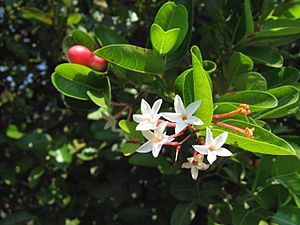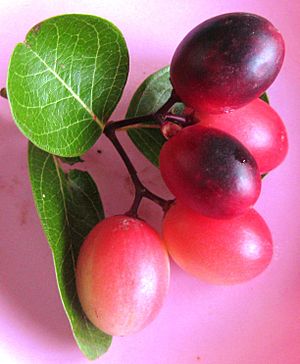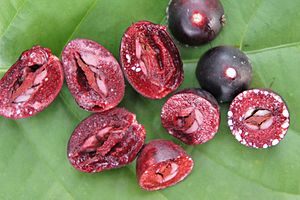Carissa carandas facts for kids
Quick facts for kids Carissa carandas |
|
|---|---|
 |
|
| Scientific classification | |
| Genus: |
Carissa
|
| Species: |
carandas
|
| Synonyms | |
|
|
Carissa carandas is a type of flowering shrub. It belongs to the plant family Apocynaceae. This plant grows small, berry-like fruits. These fruits are often used as a condiment in pickles and spices, especially in India.
The Carissa carandas is a very strong plant. It can handle dry weather well. It also grows easily in many different kinds of soil. Some common names for this plant in English are Bengal currant, Christ's thorn, carandas plum, karonda, and karanda.
Contents
Where Does the Karonda Plant Grow?
This plant loves warm places. It grows a lot in the Western Ghats region of India, especially in the states of Maharashtra and Goa. You can also find it growing naturally in the Himalayan Siwalik Hills in India and Nepal. Here, it grows at heights from about 30 meters to 1800 meters (about 100 to 5,900 feet).
In other parts of India, like Rajasthan, Gujarat, Bihar, West Bengal, and Uttar Pradesh, it is grown in smaller amounts. You can also find it in other South Asian countries. These include the lowland rainforests of Sri Lanka, and in Pakistan, Nepal, Afghanistan, and Bangladesh.
How to Grow Karonda Plants
Karonda plants are usually grown from seeds. These seeds are planted in August and September. The best time to plant them is after the first monsoon rain. Plants grown from seeds will start to produce fruit about two years later.
Sometimes, people use other methods to grow new plants. These methods include budding and inarching, which are types of grafting. You can also try growing new plants from cuttings. The plant starts to flower in March. In Northern India, the fruits are ready to pick from July to September.
What Are Karonda Fruits Used For?
Food and Health Benefits
Karonda fruits are very healthy! They have a lot of iron, vitamin C, vitamin A, calcium, and phosphorus.
In ancient Indian medicine, called Ayurveda, the fruit is used for many things. It can help with problems like indigestion, skin diseases, and stomach pain. People also use it for fresh wounds, urinary issues, and anemia. A special tea made from the leaves can help with fever, diarrhea, and earache. The roots are used to help with stomach problems, get rid of worms, and even keep insects away.
In India, the ripe fruits are picked to make Indian pickles. The fruit also contains pectin, which is a natural gelling agent. This makes it great for making chutney. When you pick a ripe fruit from the branch, a white liquid comes out.
One popular use for this fruit is as a fake cherry in cakes and puddings. You can often buy it in bottles. It's processed like traditional candied fruit, with the seeds removed. During the time of the British Raj in India, people also made jelly, jams, and syrups from karonda.
Other Uses of the Plant
The karonda plant was used in the Great Hedge of India (from 1803 to 1879 CE). This was a very long hedge built across India. The karonda was perfect for this because it's easy to grow and can handle dry weather. It's a strong shrub that grows well in many soils. It also grows quickly and thickly, needing little care, which made it ideal for creating a dense hedge.
See also
 In Spanish: Carissa carandas para niños
In Spanish: Carissa carandas para niños
Images for kids





